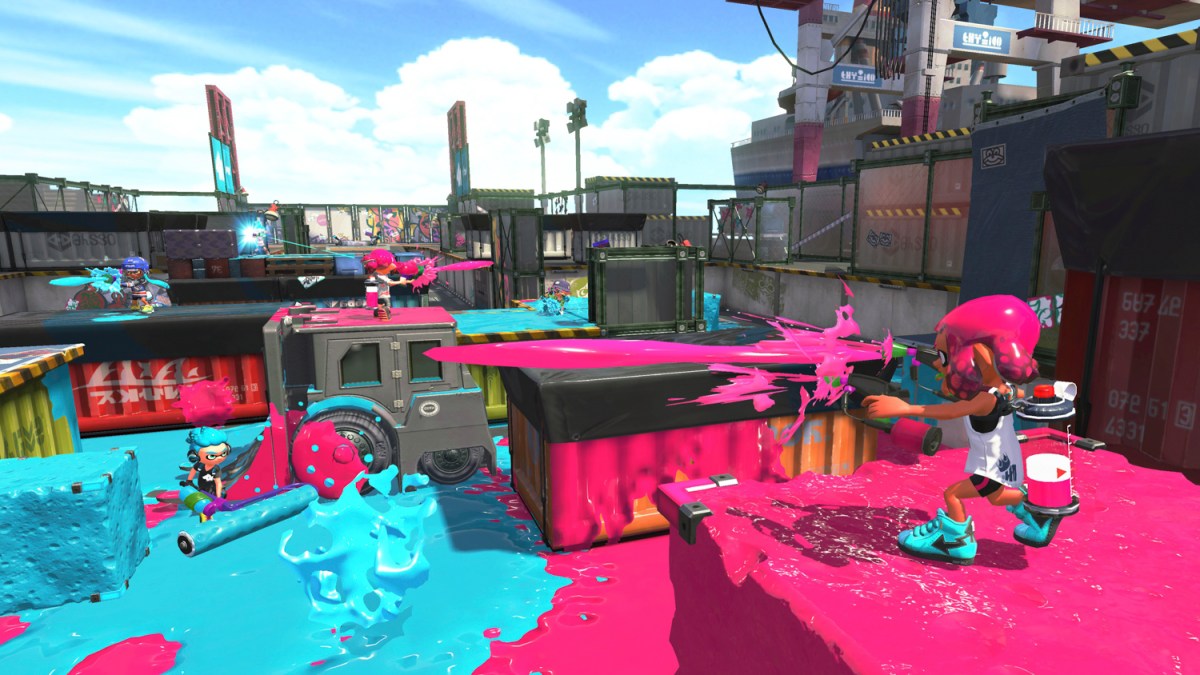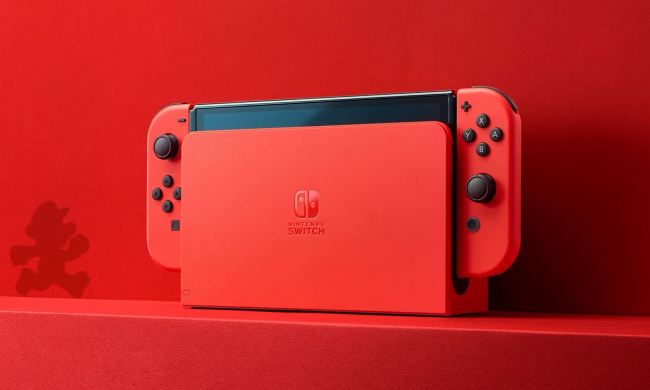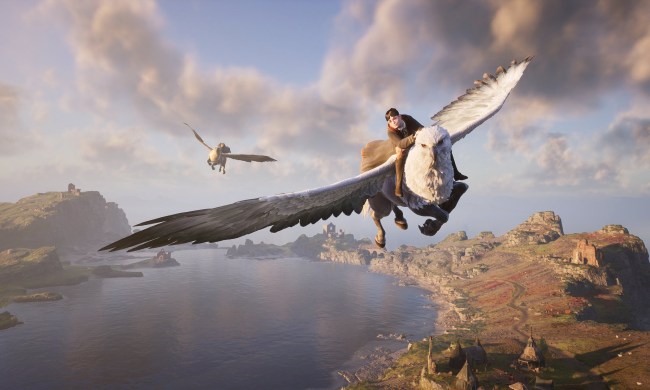- Hilarious across all three main modes
- Creative and colorful design
- Salmon Run changes up the formula
- Turf War is as intense and addictive as ever
- Multiplayer matchmaking is still archaic
- No new competitive modes
Splatoon 2 doesn’t reinvent the wheel. The sequel to Nintendo’s family friendly take on the team-based multiplayer shooter feels almost identical to the 2015 Wii U game that came before it. While there are small improvements and flourishes throughout, Its campaign and competitive multiplayer modes hit on several of the same beats as its predecessor. As our Splatoon 2 review will tell you, the sequel is a vehicle for more of the original’s gameplay.
And that’s okay. The original Splatoon stands as one of the most underappreciated games of the last generation simply because it released on the failed Wii U console. Armed with ink-filled cannons, squid-kid hybrids known as Inklings try to cover each multiplayer stage in as much color as possible while defending against enemies attempting to do the same. It’s a bright, energetic, and hilarious concoction, and a lot of people never got a chance to play it.
Splatoon 2 manages to improve on the original in several important ways. If you don’t take your competition, or yourself, too seriously, it might be your go-to game this summer.
Save the Squid Sister, save the world
Much like the 2015 original, Splatoon 2’s focus is largely on the competitive multiplayer, but it would be a mistake to discount just how creative, funny, and well-designed the game’s single-player campaign is. Taking place two years after the events of the original Splatoon, the city of Inkopolis once again finds itself in crisis after the Great Zapfish goes missing, presumably the work of rival half-fish species, the Octarians.
Another beloved Inkopolis citizen, the “Squid Sister” and pop star Callie, has also gone missing, and bizarre messages have begun transmitting back to her cousin Marie. It’s up to you, a fresh Inkling called “Agent 4,” to make your way through Octo Canyon to rescue both the Great Zapfish and Callie, all while battling against hordes of increasingly difficult Octarians.
Splatoon 2 doesn’t divert from the campaign formula established in part one. Each level features a number of small Zapfish hostages, and rescuing them all unlocks a boss stage. Despite the structural similiarties, Splatoon 2 manages to avoid making its levels feel like filler. They’re filled with a remarkable mix of platforming challanges that require you to use all of your skills in order to prevail.
Whether you’re playing on a television or directly on the Switch, Splatoon 2 runs smoothly.
These challenges mostly revolve are around Splatoon’s distinctive point-of-control focused shooting and movement mechanics. When you spray the ground or a wall with your ink, you can transform into a squid a swim through it at high speed. This allows you to jump and reach previously unavailable areas, and many of the levels’ other obstacles also interact with ink. Sponges swell up in size, creating new platforms, while rugs will unfurl after being shot. Some platforms are even completely invisible until they’re hit with ink.
If you’ve played the original game, you may find some of the campaign’s obstacles familiar, but even in these cases, Splatoon 2 does a better job of balancing the difficulty. While initially a walk in the park, as you make it to the end of the campaign after five or so hours, you’ll hit a few roadblocks that force you to use your Udon noodle a little bit more. Occasionally, the challenge can lie in having to use a weapon you’re not familiar with, which can feel more frustrating than rewarding.
While you do sometimes have the ability to customize your loadout, many of Splatoon 2’s obstacles require the use of a sniper or dual-wielding pistols. If you find yourself turned off by any of these, expect a few less enjoyable missions.
Splatoon 2 runs smoothly regardless of whether or not the Nintendo Switch is docked, with no framerate drops or glitches. Still, we think traditional dual-stick aiming is still the way to go. While the motion controls can make vertical aiming a little more precise, it has a tendency to be more trouble than it’s worth when moving left or right. The Nintendo Switch Pro Controller, with its larger sticks, are probably your best option precise controls and quick aiming.
The game’s creativity is most apparent in its boss battles, which offer a healthy challenge without feeling punishing to less-experienced players. Building on the mechanics and abilities you’ve learned in the preceding levels, each battle puts you up against an enormous Octarian with a few unique and frequently hilarious abilities. The first of these is a giant oven that attempts to crush you with giant loaves of bread that you must turn into toast in order to come out unscathed.
Splatoon 2’s writing is even funnier than what we saw in the original game. Its themed bosses pack in so many jokes that you’ll almost certainly miss a few. Before the boss fight against the bread oven, for example, Marie warns you to not let things go “a rye.” Puns come at a lightning pace — not just within the campaign missions, but also from squid citzens (squidizens?) you encounter in the game’s hub world. The food vendor, whose actual name is “Crusty Sean,” opens up a conversation by asking, “What’s kraken, squiddo?” We wouldn’t have it any other way.
The old stomping grounds
Most players will put the majority of their time with Splatoon 2 into “Turf War,” the game’s competitive multiplayer. The rules remain unchanged from the original game, with two teams of four working to cover their map in ink in a very short time period.
Players have to make use of all of their abilities in order to succeed in Turf War.
Unlike the campaign missions, you’re free to pick any weapon you like for use in Turf War, provided that you’ve unlocked it with the game’s currency. With any luck, you’ll have already picked a favorite from your time with the single-player content, and you’ll be ready to blast away at enemies before transforming into a squid and zipping around the level.
Our personal favorite during our Splatoon 2 review was the “Splat Dualies,” a set of automatic pistols capable of devastating enemies as close range, but just about every play-style has a weapon that fits the bill. Care to just run enemies over? Try out the “Splat Roller.” If you prefer to hang back and pick off targets from afar, the “Splat Charger” might be more your style.
In addition to your weapons and clothing – which improve over time, accruing statistical bonuses with repeated use in multiplayer matches – you’ll also have a few special abilities to use against opponents. While some less-effective guns might come packaged with a devastating mine or missile barrage ability, other powerful weapons come with a small armor boost that rarely turns the tide of a battle.
What makes Turf War so exhilarating is that players have to make use of all of their abilities in order to succeed. Easing off for just a few seconds can cause a team to lose a game – all that matters is which team controls more of the map at the end of a match, and it isn’t uncommon to see one side launch an all-out assault to regain a majority as the final seconds count down. Though it can be demoralizing to be on the losing end of one of these battles, it typically only takes 10 to 20 seconds before you’re ready to jump back into the fray.
For more dedicated players who have reached level 10 or above, Splatoon 2 also features ranked multiplayer matches that move away from the traditional Turf War model and force teams to control specific areas of the map. All three modes from the original – “Splat Zones,” “Tower Control,” and “Rainmaker,” return in Splatoon 2. The first two have teams task players with controlling small areas of the map, while the latter mode has each team attempting to move an enormous weapon to the enemy’s base like a game of reverse capture-the-flag.
Unfortunately, during our time with Splatoon 2, the ranked modes remained largely unpopulated, but we were able to play several Splat Zones matches. With all eight players focused on a tiny square or two of a larger map, Splat Zones is far more intense than a standard Turf War match, and it pays for players to diversify their lineups. With one Inkling setting up shop with a Splat Charger on an elevated area, the enemy team can be easily picked off before they have a chance to capture the objective.
Splatoon 2 is a remarkable multiplayer shooter with all the style, attention to detail, and polish that we’ve come to expect from Nintendo.
Most of Splatoon 2’s multiplayer changes are subtle, but are still important to the game’s success. Its maps still look just as fresh as in the original, and feel incredibly well balanced. Most courses make it extremely difficult for a team to rush an enemy’s spawning zone and set up camp just outside of it, and the maps’ varied elevations and jumps make it unlikely that an entire team will every stick together for more than a few seconds.
That being said, if players make use of the game’s limited communication functions, which allow teammates to quickly point out areas of interest using the directional pad, they can still coordinate attacks on the fly. The Nintendo Online voice chat app is scheduled to launch alongside the game on July 21, which may allow for more coordination. Considering all the extra steps needed to connect the phone to the game, however, its convoluted setup process makes it unlikely that team chat will catch on.
The one place where Splatoon 2’s lack of dramatic evolution does fall short, however, is in online matchmaking, which feels beyond outdated in 2017. Once you begin searching for a match, regardless of mode, it is not possible to cancel and start a new search until the timer counts all the way down. This can sometimes take a couple of minutes. If you find that there aren’t enough people playing at any given moment, your only other choice is to completely close and restart the game.
If you want to play a specific map or ranked multiplayer mode online, you better hope that it’s in the game’s current rotation. Switching out every couple of hours, just like it did in the original Splatoon, only two Turf War maps are playable at any one time.

Limiting players’ choice is likely a way for Nintendo to guarantee that all of the game’s maps and modes are played, even ones that aren’t particularly popular. It made sense on the struggling Wii U platform, but the Switch is selling like hotcakes and players will stick around. Forcing them to play the same two maps for hours at a time will only make them lose interest quickly.
In addition to the multiplayer and campaign modes, Splatoon 2 also includes a brand new cooperative offering called “Salmon Run.” Two to four players must work together to defend themselves against waves of “Salmonids,” while also collecting golden eggs for the corporation Grizzco. While it’s a simple adaptation of wave-based “horde mode” style co-op found in other shooters, it is surprisingly addictive.
If you’ve ever wanted to fight a fish standing on top of a pile of dirty dishes or a metal umbrella-wielding, rocket-firing salmon, you’re in luck. Salmon Run’s difficulty is unlikely to faze anyone who has played the game for more than a few hours, but Nintendo doesn’t seem to want players to spend hours with Salmon Run, anyway.
The mode is only available online during certain days, during which participants can collect extra prizes, including powerful gear, for use in multiplayer. While it was unlikely that there would ever be a hardcore Salmon Run community, the decision to artificially limit Splatoon 2’s content is baffling. It’s also, like the rest of Splatoon 2, not playable in split-screen. If you friend wants to join in, they’ll need their own system.
Our Take
Splatoon 2 is a remarkable multiplayer shooter with all the style, attention to detail, and polish that we’ve come to expect from Nintendo. Based on how Nintendo supported the original, we expect the game to to receive free content updates for a long time, which will continue sucking enthusiastic squid kids in for months, if not years. Even if you don’t plan on playing it competitively for years to come, however, Splatoon 2 will put a smile on your face, and that’s just as important.
Is there a better alternative?
No. Splatoon 2 is unlikely anything else on the Nintendo Switch, and it’s an improvement over the original game.
How long will it last?
The campaign can be completed in just a few hours. Competitive and co-op multiplayer should continue making fun for you as long as there are players coming back to it.
Should you buy it?
Yes. Whether you like playing alone, competitively, or cooperatively, Splatoon 2 has something here for you.








